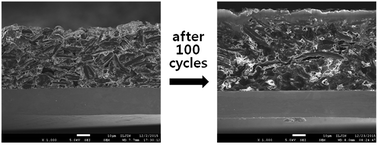Graphite–silicon alloy composite anodes employing cross-linked poly(vinyl alcohol) binders for high-energy density lithium-ion batteries
Abstract
A new silicon alloy material composed of silicon nanoparticles embedded in Al–Fe–Ti–Ni matrix phases was synthesized and characterized. Using this alloy material, graphite–silicon alloy composite electrodes were prepared and investigated as anodes for lithium-ion batteries. Poly(vinyl alcohol)s (PVAs) with different degrees of cross-linking were used as polymer binders in these composite anodes. A systematic study demonstrated that the cross-linking of PVA with an appropriate amount of fumaric acid made the electrodes mechanically strong and remarkably improved the electrochemical performance of the composite electrodes. Their superior cycling performance could be attributed to strong adhesion of the three-dimensional PVA networks, which maintained good electrical contacts between the active materials, electronic conductors and current collectors during cycling. The graphite–silicon alloy composite electrodes exhibiting high capacities and good cycling stability showed promise as anodes for high-energy density lithium-ion batteries.


 Please wait while we load your content...
Please wait while we load your content...